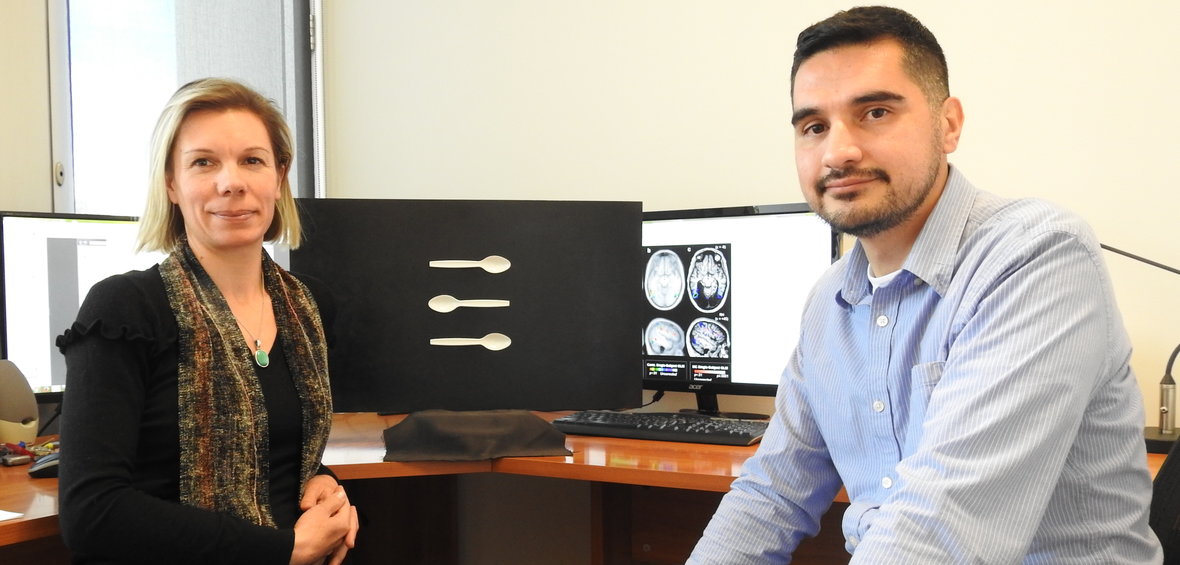Does having the potential to act upon an object have a unique influence on behavior and brain responses to the object? That is the question Jacqueline Snow, assistant professor of psychology at the University of Nevada, Reno, has set out to answer.
Her lab examines how and why real tangible objects are processed and represented differently in the human brain compared to representations of objects, such as two-dimensional (2-D) computerized images, three-dimensional (3-D) stereo images, and immersive 'virtual' reality displays. Her work investigates real-world cognition using convergent experimental approaches that include behavioral psychophysics, neuropsychology, fMRI, EEG, eye-tracking and augmented reality (AR).
Snow, with the University's College of Liberal Arts, and her graduate students, Michael Gomez and Rafal Skiba, recently submitted a paper on the findings of their research study, "Graspable objects grab attention more than images do" which will be published in an upcoming issue of Psychological Science, a top-tier psychology journal.
Their study looked at whether having the potential to act upon objects influences how humans allocate attention to different objects in a scene. They examined whether real objects compete more strongly for attention and manual responses compared to matched computerized 2-D and 3-D images of the same objects.
To answer this question, the authors used a 'flanker' paradigm, in which healthy human observers were asked to make quick responses to a central target stimulus while ignoring irrelevant objects that flanked the target from above and below. We typically take longer to respond to a central target (e.g., a spoon with a rightward-oriented handle) when it is flanked by distractors that would elicit a different manual response to that of the target (e.g., spoons with leftward-oriented handles). Slower reaction times to the target reflect the extent to which the irrelevant flankers have captured attention.
The authors hypothesized that because real objects afford genuine actions (i.e., grasping) they should be more powerful competitors for attention than 2-D or 3-D images of the same objects (which do not allow grasping). In line with this idea, the study found the irrelevant real object flankers slowed response times to the central target more than the 2-D or 3D image flankers. Critically, however, this effect disappeared when the stimuli were placed out of reach of the observer, as well as when the stimuli were presented within reach, but behind a large transparent barrier that prevented the opportunity for manual interaction with the stimuli.
Together, the results demonstrate, for the first time, that real objects exert a more powerful influence on attention and manual responses than do computerized images of objects, because images are not relevant for action.
{{RelatedPrograms}}
"These results challenge the long-held notion that images are appropriate proxies for real objects in the study of human brain function," Snow said. "These findings suggest a number of exciting avenues for future research, such as whether similar effects are found when observers look at more immersive 3-D stimuli presented using augmented reality (AR) displays. AR stimuli are particularly interesting to us because the observer can to grasp and move the (virtual) objects."
Other findings from the Snow lab include discovering that the human brain responds differently to real objects versus 2-D photos of objects and that real objects are more memorable than 2-D images. Snow, together with her students Carissa Romero and Michael Compton, have also discovered recently that snack foods presented as real objects are valued more than snacks presented as 2-D images - a study soon to be published in the journal Cortex.
Snow went on to explain that the study raises important questions in the field of psychology.
"These findings are important because much of what we know about the human brain and cognition is based on studies that have relied on relatively impoverished 2D images presented on a computer screen," Snow explained. "In my lab, we are investigating how, and why, the brain processes real, tangible objects differently to images. Humans appear to be very sensitive to whether or not they are looking at an image, or a real object, and whether the object itself is within reach."
Snow's research on this project was funded by an R01 grant from the National Eye Institute of the National Institutes of Health (NIH).












